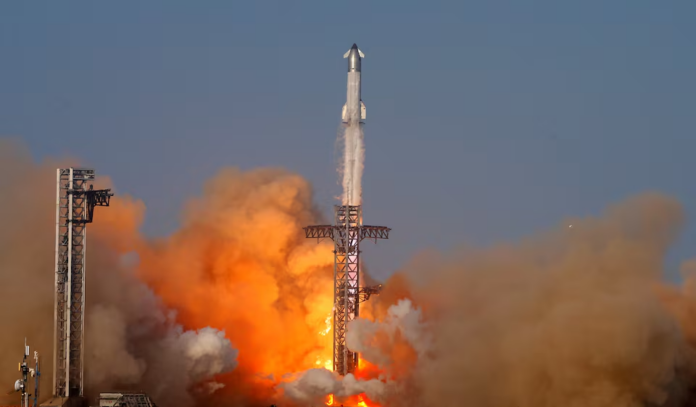SpaceX’s Starship rocket launched from Texas on Tuesday but lost control halfway through its flight, failing to meet several key testing objectives and posing new challenges for CEO Elon Musk’s Mars rocket program.
The 400-foot Starship system lifted off from SpaceX’s Starbase launch site, surpassing the altitude of two earlier test attempts that ended in explosions earlier this year. This ninth full test mission marked the first time the upper-stage spacecraft was launched on top of a previously flown booster, demonstrating reusability.
During descent, SpaceX lost contact with the 232-foot lower-stage booster, which crashed into the sea instead of making a planned controlled splashdown. Meanwhile, Starship entered suborbital space but began spinning uncontrollably about 30 minutes into the flight after SpaceX canceled plans to deploy eight mock Starlink satellites due to a mechanism failure.
SpaceX broadcaster Dan Huot said on a company livestream that the mission was not meeting many on-orbit objectives. Musk was scheduled to deliver an update at Starbase on the company’s space exploration plans but had not done so hours after the launch.
Musk posted on X that the rocket experienced a fuel leak in its primary tank, which led to the loss of control. He added that data from the launch would be reviewed and that the next three flights would be scheduled about every three to four weeks.
The recent setbacks come amid SpaceX’s efforts to build a multipurpose rocket capable of carrying large numbers of satellites, supporting lunar missions, and ferrying astronauts to Mars. The company uses a flight-testing approach that involves pushing spacecraft to failure to identify improvements through repeated tests.
Tuesday’s flight was intended to complete nearly a full orbit of Earth, with a controlled splashdown in the Indian Ocean to test new heat shield tiles and revised flaps designed for re-entry and descent. Instead, the rocket broke apart over southern Africa.
Federal regulators had approved the launch four days prior, following a mishap investigation that grounded Starship for nearly two months. Two earlier test flights this year ended in explosions shortly after liftoff, scattering debris over Caribbean islands and disrupting airline flights.
The Federal Aviation Administration expanded debris hazard zones for Tuesday’s launch. The previous failures occurred during early flight phases that SpaceX had cleared in earlier tests, marking a setback for Musk’s accelerated development schedule.
Musk, who founded SpaceX in 2002, has indicated that he plans to refocus on his business ventures, including SpaceX, after recent political activities. The Starship rocket is expected to replace SpaceX’s Falcon 9 rocket in the company’s commercial launch business, which currently carries most of the world’s satellites to orbit.
NASA plans to use Starship for crewed lunar landings as part of its 2027 moon mission, though the program faces challenges amid Musk’s influence and U.S. policy shifts.























